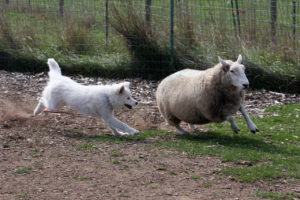Progressive Retinal Atrophy
PROGRESSIVE RETINAL DEGENERATION / PROGRESSIVE RETINAL ATROPHY
Progressive retinal degeneration (PRD) is also known as progressive retinal atrophy (PRA) and refers to retinal diseases that cause blindness. Some breeds have blindness by abnormal development of the retina and this is called dysplasia. Other breeds have a slowly progressive degeneration or death of the retinal tissue and this is degeneration. These two types of diseases affect many breeds. In general these diseases are thought to be inherited but inherited differently in each breed.
In all animals with PRD the outcome, age of the patient and what the veterinary ophthalmologist sees are the basis for the classification of exactly what type of condition the patient has. Different breeds of dogs have variations in the age the problem starts and speed with which the blindness develops. The condition of PRD has been seen in almost every registered breed and in mixed breed dogs as well. This same condition occurs in humans and is known as retinitis pigmentosa.
As the name PRD implies, a slow death of retinal tissue occurs. It is a slowly progressive disease and the earliest signs may be overlooked. As stated above, these diseases are known to be passed from parents to offspring even though the parents may have normal eyes. Therefore, identification of breeding animals with PRD is essential to prevent spread of this condition.
To better understand PRD, a basic understanding of the function of the retina is needed. The retina is a highly complicated tissue located in the back of the eye. Light strikes the retina and starts a series of chemical reactions that causes a nerve impulse. The impulse passes through the layers of the retina to the optic nerve and from there to the brain where vision takes place. In the retina, cells called rods are involved with black and white or night vision and cells called cones are involved with color or day vision. Progressive retinal degeneration may effect either the rods alone, the cones alone or both the rods and cones together.
Progressive retinal degeneration is not a painful condition so your pet will not have a reddened eye or have increased blinking or squinting. For this reason most clients will not notice the early stages of the condition. Some clients will notice an abnormal shine coming from their pet’s eyes. This abnormal shine is because the pupils are dilated and don’t respond as quickly to light as pupils of normal dogs. The earliest signs of PRD include night vision difficulties that in most cases will progress to day blindness. Clients will often remember that their pets seemed disoriented when going out to the yard at night and they had to leave a light on for them. Night blindness may be manifested by a pet that is afraid to go into a dark room. Occasionally these pets will get lost in their own home after the lights have been turned off.
The veterinary ophthalmologist examines the retina with an instrument called an indirect ophthalmoscope. Changes in the retinal blood vessel pattern, the optic nerve head, and the reflective substance within the dog’s eye called the tapetum can be seen which are classic for PRD. However in some breeds PRD characteristics have little or no early changes. The eyes of these dogs may appear normal until they are in the later stages of the disease. Progressive retinal degeneration will progress at different rates in different breeds. This variation causes difficulty in determining just how long any particular dog will continue seeing.
There is no possible treatment for PRD although a number of vitamin therapies have been suggested by various people. One such vitamin “Ocuvite” manufactured by Stortz has been recommended for people with retinitis pigmentosa and some patients claim that their vision is improved somewhat. At this time, none of the vitamin treatments have been proven to be effective scientifically, so use of Ocuvite must be deemed a naturopathic remedy rather than a medical treatment. Use of any other megavitamin treatment is discouraged.
Cataracts may occur in some patients with PRD and generally occur later in the disease. Formation of cataracts may interfere with the ophthalmologist’s direct examination of the retina and make other tests such as an electroretinogram (ERG) essential for diagnosis.
Diagnosis is made and confirmed by the ERG. This test involves sophisticated instrumentation used to measure the response of the retina to flashes of light. Your pet would be anesthetized for this test. The pet is then placed into a darkened area, a special contact lens with a gold ribbon is placed on the cornea and two tiny needles are placed under the skin around the eye. A light flash that has been dimmed with filters stimulates the retina and this procedure is repeated intermittently for 20 minutes. Finally, a bright red, blue and white flash are used for final analysis. A healthy retina will produce a characteristic wave form that builds from the time the lights are turned out. The ERG is sensitive enough to diagnose dogs with PRD before they begin to demonstrate signs of the disease.
In summary, PRD refers to a broad group of inherited retinal disease which result in the blindness of dogs. Because of the nature of the disease and sometimes the late onset, repeated examinations may be required to detect individuals with the condition. Patients affected should not be used for breeding. Pedigree studies are used to help eliminate other carriers of this condition such as the pet’s brothers, sisters, mother, father and any offspring. How to adjust to having a pet that is blind is important and is discussed on the web page entitled How to Deal with a Blind Pet.
For more information on PRA in dogs, Dr. Gregory Acland has produced some excellent reference material located at The Dog Genome Project Homepage.
Written by Dr. Dennis Hacker, Edited by Dr. Michael Zigler
Copyright ©2001, Eyevet Consulting Services.







